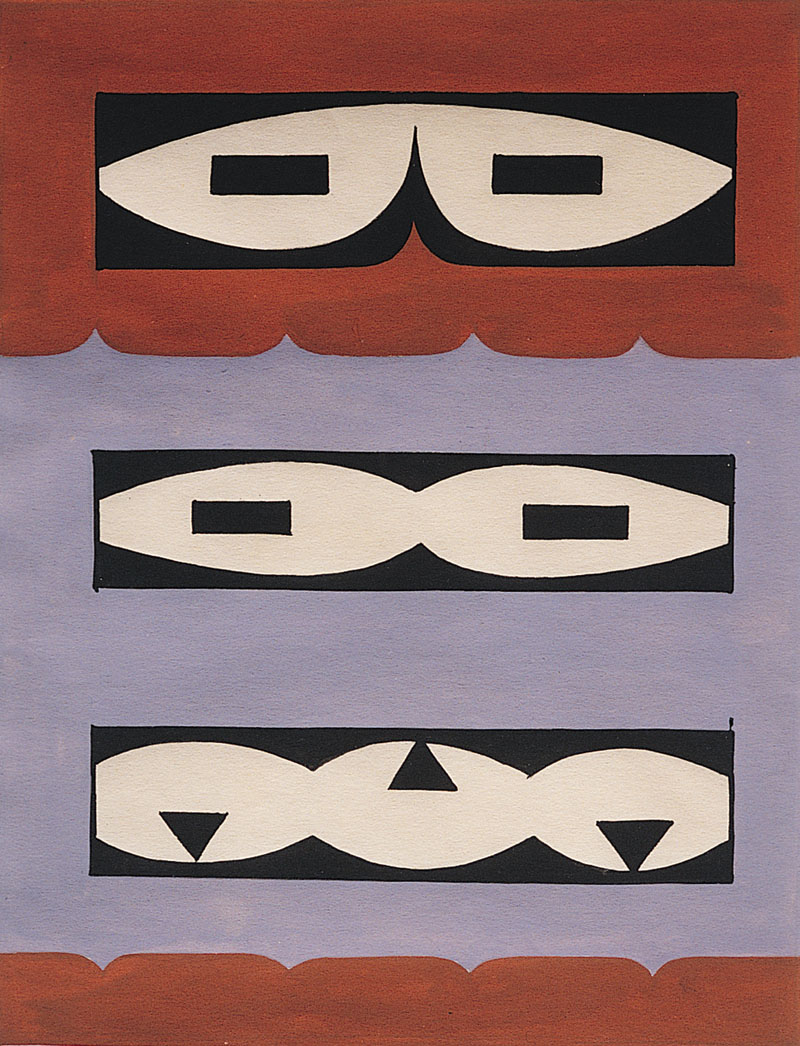Gordon Frederick Walters was born in Te Whanganui-a-Tara. At his secondary school, Rongotai College, art was no part of the curriculum. In 1935, he began training as a commercial artist while studying part-time at the Art Department, Wellington Technical College. He taught there part-time in 1945. It is important to note that Walters’ period of study coincided with the war years, so he was deprived of any direct contact with European art. What he did know came from reproductions and a few books on contemporary art. His interest in non-Western art grew from the study of the ethnographic collections of the Dominion Museum.
In the war years, Walters worked as an illustrator for the Ministry of Supply. His 1941 meeting and friendship with the Indonesian-born Dutch artist Theo Schoon was of crucial importance. In 1946, Schoon introduced him to Māori rock art in South Canterbury and North Otago. In the same year, he went to Australia for some months> This was the first of many trips made there in order to enlarge his artistic horizons. These two experiences triggered works in which Walters rejected the spatial conventions of his art training in favour of ‘primitivist’ paintings influenced by surrealism and the work of Paul Klee and Joan Miró.
Such works did not elicit a ready public response, forcing the artist to work in almost complete isolation after the failure of his first exhibition at Wellington Public Library in 1949. In fact, it was not until 1966 that he was able to paint full-time. He left for Europe in 1950, spending most of his time in London, but viewing exhibitions of work by Victor Vasarely, Auguste Herbin, and other abstractionists in Paris. In Holland, he saw paintings by Piet Mondrian, work by Bauhaus members, and a major exhibition of contemporary American painting. On returning to Aotearoa in 1953, he settled in Te Whanganui-a-Tara and worked in the Government Printing Office.
In 1956, Walters began his first studies using the koru, or pītau, motif. This, combined with hard-edge modern abstraction, was to provide the basis of much of his life’s work. His first solo exhibition in seventeen years took place at Auckland’s New Vision Gallery in 1966. In 1963, Māori culture had entered his life in a new way when he married the scholar Margaret Orbell. She was editor of Te Ao Hou, a Māori culture and arts magazine for which he worked as designer and graphic artist. In 1971, he moved to Tāmaki Makaurau, where he was Visiting Lecturer in Painting at Elam School of Fine Arts in 1972. Among his students were Stephen Bambury, Richard Killeen, Ian Scott, and Geoff Thornley. During this year, Walters, his students, and the art dealer Petar Vuletic all became involved in intense discussions about abstract art.
On Orbell’s 1976 appointment as Lecturer in Māori at the University of Canterbury, the artist moved to Ōtautahi. In 1979, he travelled to the United States of America. He was the subject of a major retrospective at the Auckland City Art Gallery (now Auckland Art Gallery Toi o Tāmaki) in 1983. This toured the country in reduced form and made the public aware of his enormous importance to the development of modernism in Aotearoa. In 1989, he celebrated his 70th birthday and the occasion was marked by the publication of a festschrift of essays, Gordon Walters: Order and Intuition. In the wake of the Sydney Museum of Contemporary Art’s 1992 Headlands exhibition of New Zealand art, Walters found himself the central figure in a debate over his apparent appropriation of Māori imagery. In 1994, Parallel Lines: Gordon Walters in Context placed many of his works alongside those of European and American artists who had influenced him.
